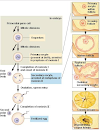GAMETOGENESIS
The life of a human begins when the male sex cell (sperm) unites with the female sex cell (ovum). This process is called fertilization. The sex cells are also called gametes. The process of gamete formation is called gametogenesis. Female gamete is the ovum so the process of ovum formation is called oogenesis.
Male gamete is the sperm, so the process of sperm formation is called spermatogenesis.
Gametogenesis is of two types:
Spermatogenesis
Here we will learn spermatogenesis.
SPERMATOGENESIS:
The process of sperm formation is called spermatogenesis. Primordial germ cells originate in the wall of yolk sac and migrate to the developing testes in the week-4 of intrauterine life and remain dormant here, until the onset of puberty. Seminiferous tubules of testes are solid structures before puberty they acquire lumen at puberty and come to be lined by two types of cells.
Sertoli or supporting cells.
And
Spermatogonia or spermatogenic cells.
Spermatogonia are derived from primordial germ cells. They undergo mitosis to provide a continuous supply of stem cells ( type A spermatogonia) throughout the reproductive life of the male. And type B spermatogonia which give rise to primary spermatocytes. Each spermatogonium has 46 single structured chromosomes and 2 N DNA.
Soon after their formation, primary spermatocytes enter meiosis l by undergoing DNA replication and come to have 46 double structured chromosomes and 4N DNA. Prophase is long and it takes about 22 days to proceed to metaphase, anaphase, and telophase to complete meiosis 1. At the end of meiosis I, each primary spermatocyte gives rise to two secondary spermatocytes each containing 23 double structured chromosomes and 2N DNA.
Two secondary spermatocytes quickly undergo meiosis ll to form four spermatids each containing 23 single structured chromosomes and 1N DNA. With the appearance of spermatids spermatocytogenesis ends. Thereafter spermatids undergo a complex process of differentiation called spermiogenesis. It results in the transformation of spermatids into spermatozoa.
During the process of spermatocytogenesis from spermatogonia to spermatids, the resulting cells do not separate completely but remain held together by cytoplasmic bridges. These intercellular bridges provide communication between cells. The information is interchanged thus coordinating the sequence of events in spermatocytogenesis.
Furthermore, spermatogonia, spermatocytes, and spermatids remain embedded in deep recesses of Sertoli cells throughout their Development. In this way, sertoli cells provide support protection, nutrition and assist in the release of mature spermatozoa.
Note:
The sex chromosomes in a primary spermatocyte are XY. After meiosis 1 one secondary spermatocyte comes to have an X chromosome and the other secondary spermatocyte comes to have a Y chromosome as it is a simple reduction division. After meiosis II the spermatids originating from X bearing secondary spermatocyte come to have X chromosomes and the spermatids originating from Y bearing secondary spermatocyte come to have Y chromosomes as it is a simple mitotic division.
SPERMIOGENESIS:
Maturational changes in spermatids resulting in the formation of mature spermatozoa is called spermiogenesis. It is the final stage of spermatogenesis. Spermatids are rounded or polygonal cells with a nucleus having areas of condensed chromatin. During spermiogenesis, the following changes occur in spermatids.
- In the golgi apparatus appear acrosomal granule, acrosomal vesicle and then the acrosomal cap in succession one after the other containing several hydrolytic enzymes like Hyaluronidase, Neuraminase, Acid phosphatase and a protease having trypsin like activity. Acrosome extends over half the nuclear surface.
- The nucleus gets condensed and assumes a characteristic shape.
- The centrioles migrate to the opposite poles of the spermatid. From one centriole a flagellum emerges. The other form a collar around the initial part of the tail.
- The mitochondria arrange themselves around the initial part of the tail as a spiral.
- The excess cytoplasm is cast off as a residual body which is phagocytosed and digested by Sertoli cells. Cytoplasmic bridges also get lost and individual sperms are thus formed.
In human, the time required for a spermatogonium to develop into a mature sperm is approximately 64 days. Spermatogenesis occurs neither simultaneously nor synchronously in all the seminiferous tubules. The process occurs in a wave like fashion which explains the irregular appearance of tubules where each region exhibits a different phase of spermatogenesis.
Mature sperms after release from Sertoli cells leave the lumen of seminiferous tubules and enter the duct of the epididymis. They take about 20 days to travel to 6 meters long tortuous duct of the epididymis. During this process, they become motile and physiologically active. They retain this ability for a limited period. If ejaculation does not occur they degenerate and die.











0 Comments